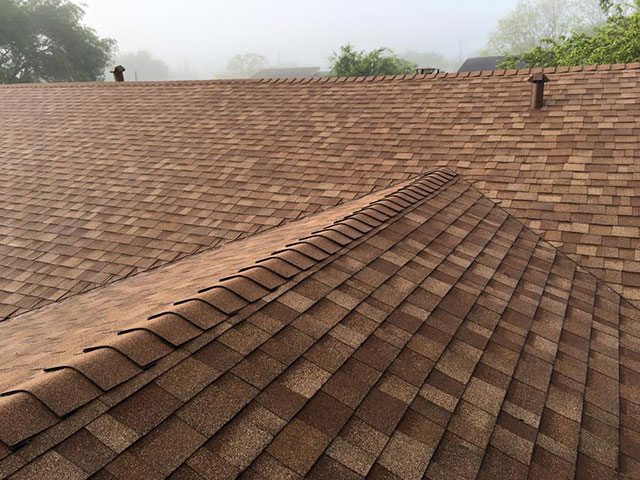Your roof is one of the most critical components of your home, offering protection from the elements while contributing to its aesthetic appeal and energy efficiency. With so many different roofing materials available, choosing the right one can feel overwhelming. This comprehensive guide will help you understand the pros and cons of various roofing materials, so you can make an informed decision that suits your home’s needs, budget, and style.
1. Asphalt Shingles
Asphalt shingles are the most common roofing material in the U.S. due to their affordability and ease of installation. Available in a wide range of colors and styles, they are a versatile option for many types of homes.
Pros:
– Affordable and widely available.
– Easy to install and replace.
– Comes in a variety of colors and styles.
– Offers decent durability with a lifespan of 20–30 years.
Cons:
– Susceptible to wind and storm damage.
– Not as eco-friendly as other options.
– Shorter lifespan compared to premium materials like metal or tile.
Best For:** Homeowners looking for an affordable, traditional roofing option that offers reasonable durability.
2. Metal Roofing
Metal roofing has grown in popularity due to its durability, energy efficiency, and modern appearance. Available in a variety of styles, including panels and shingles, metal roofs are ideal for homes in areas prone to extreme weather conditions.
Pros:
– Extremely durable, with a lifespan of 40–70 years.
– Lightweight and eco-friendly (often made from recycled materials).
– Reflects heat, making it energy-efficient and ideal for warmer climates.
– Resistant to fire, wind, and pests.
Cons:
– Higher upfront cost than asphalt shingles.
– Can be noisy during rainstorms if not properly insulated.
– Requires specialized installation to avoid potential leaks or dents.
Best For:** Homeowners in regions with harsh weather or those looking for a long-lasting, energy-efficient roofing option.
3. Clay and Concrete Tiles
Clay and concrete tiles are known for their durability, classic appearance, and ability to withstand harsh climates. They are often used in Mediterranean, Spanish, and Southwestern-style homes, adding a distinctive and elegant look.
Pros:
– Extremely durable, with a lifespan of 50–100 years.
– Resistant to fire, rot, and insect damage.
– Excellent insulation, helping regulate indoor temperatures.
– Low maintenance and eco-friendly (often made from natural materials).
Cons:
– Very heavy, requiring reinforced roofing structures.
– Expensive compared to asphalt and metal options.
– Can break or crack under impact (like falling branches).
Best For:** Homes in warm climates, particularly those with Mediterranean or Southwestern architectural styles, and homeowners looking for a high-end, long-lasting option.
4. Slate Roofing
Slate roofing is one of the most premium and durable roofing materials available. Made from natural stone, slate offers a timeless and elegant look while providing unmatched longevity.
Pros:
– Incredibly durable, with a lifespan of 75–150 years.
– Resistant to fire, mold, and insects.
– Adds value and curb appeal to your home with its unique aesthetic.
– Environmentally friendly, as it’s made from natural stone.
Cons:
– Extremely heavy, requiring reinforced roofing structures.
– Very expensive, both in material and installation costs.
– Fragile and can crack or chip if improperly installed.
Best For:** Historic homes or luxury properties where durability and aesthetics are top priorities.
5. Wood Shingles and Shakes
Wood shingles and shakes provide a rustic, natural look that enhances the appearance of many architectural styles. Shingles are machine-cut for a uniform appearance, while shakes are hand-split, offering a more textured look.
Pros:
– Natural and eco-friendly, especially when made from sustainably sourced wood.
– Offers excellent insulation, helping regulate indoor temperatures.
– Aesthetic appeal that works well with cottage, Cape Cod, or traditional-style homes.
Cons:
– Requires regular maintenance to prevent mold, rot, and insect infestation.
– Prone to fire unless treated with a fire-resistant coating.
– Shorter lifespan (20–40 years) compared to other premium materials.
Best For:** Homeowners looking for a rustic or traditional aesthetic, and those willing to invest in regular maintenance.
6. Synthetic Roofing Materials
Synthetic roofing materials, including rubber, plastic, and polymer-based products, are designed to mimic the appearance of more expensive materials like slate or wood while offering better durability and affordability.
Pros:
– Lightweight and easier to install than natural materials like slate or tile.
– More affordable while still offering a premium look.
– Durable and resistant to many forms of damage, including impact and fire.
– Available in various styles, textures, and colors.
Cons:
– Newer product, so long-term performance is less proven compared to traditional materials.
– Quality can vary significantly between manufacturers.
– May fade over time when exposed to sunlight.
Best For:** Homeowners who want the appearance of high-end materials at a lower cost with less maintenance.
7. Green (Living) Roofs
Green roofs, also known as living roofs, are covered with vegetation and provide an eco-friendly solution for homes. They help with insulation, reduce stormwater runoff, and improve air quality around the home.
Pros:
– Eco-friendly and sustainable, providing natural insulation.
– Reduces stormwater runoff, which helps protect the surrounding environment.
– Increases biodiversity and offers a natural habitat for wildlife.
– Helps regulate indoor temperatures by absorbing heat.
Cons:
– Requires more complex installation and maintenance.
– Initial installation costs are high.
– Limited to flat or low-slope roofs.
Best For:** Eco-conscious homeowners looking to reduce their environmental footprint and integrate green solutions into their home’s design.
8. Solar Roofing
Solar roofing, including solar shingles and panels, combines roofing materials with energy-generating technology. Solar shingles look similar to traditional roofing materials but capture solar energy to power your home.
Pros:
– Generates renewable energy, reducing utility bills.
– Adds value to your home, with many areas offering incentives or tax breaks.
– Sleek design compared to traditional solar panels.
– Environmentally friendly, reducing reliance on fossil fuels.
Cons:
– High upfront cost.
– Solar shingles are less efficient than traditional solar panels.
– Availability and effectiveness depend on geographic location and climate.Best For:** Homeowners looking to invest in renewable energy, reduce utility costs, and contribute to a more sustainable future.
9. Cost and Budget Considerations
When selecting a roofing material, it’s important to balance your budget with your home’s needs. Here’s a breakdown of the general cost range for each material:
-Asphalt Shingles:** $100–$300 per square.
-Metal Roofing:** $300–$700 per square.
-Clay/Concrete Tiles:** $600–$1,500 per square.
-Slate Roofing:** $1,000–$3,000 per square.
-Wood Shingles/Shakes:** $400–$800 per square.
-Synthetic Roofing:** $300–$600 per square.
-Green Roofs:** Varies widely based on the complexity of the system.
-Solar Roofing:** $21–$25 per square foot for solar shingles.
Conclusion: Finding the Right Roof for Your Home
Choosing the right roofing material is a significant decision that impacts your home’s appearance, energy efficiency, and overall durability. Consider factors such as your climate, budget, and design preferences when making your decision. Whether you’re looking for the affordability of asphalt shingles, the longevity of metal roofing, or the eco-friendly benefits of green roofs, there’s a material that suits your home’s needs and style. Consulting with a professional roofer will also help ensure you make the best choice for your home’s long-term protection and value.
Contact Us
Texas Coastal Roofing and Construction can help you maintain your roof’s excellent condition. We offer a variety of services. Call us today at (361) 332-1263to learn more. We serve the Corpus Christi coastal bay area including Portland, Rockport, Port Aransas, McAllen, North Padre Island, Kingsville, Mathis and more!


Recent Comments